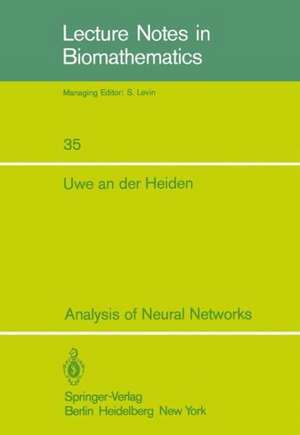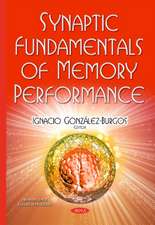Analysis of Neural Networks: Lecture Notes in Biomathematics, cartea 35
Autor U. an der Heidenen Limba Engleză Paperback – apr 1980
Din seria Lecture Notes in Biomathematics
-
 Preț: 378.54 lei
Preț: 378.54 lei -
 Preț: 380.45 lei
Preț: 380.45 lei -
 Preț: 413.37 lei
Preț: 413.37 lei -
 Preț: 390.63 lei
Preț: 390.63 lei -
 Preț: 396.24 lei
Preț: 396.24 lei -
 Preț: 387.38 lei
Preț: 387.38 lei -
 Preț: 385.08 lei
Preț: 385.08 lei - 5%
 Preț: 366.56 lei
Preț: 366.56 lei -
 Preț: 384.70 lei
Preț: 384.70 lei -
 Preț: 388.13 lei
Preț: 388.13 lei -
 Preț: 394.29 lei
Preț: 394.29 lei - 5%
 Preț: 389.93 lei
Preț: 389.93 lei - 5%
 Preț: 370.74 lei
Preț: 370.74 lei -
 Preț: 384.86 lei
Preț: 384.86 lei -
 Preț: 387.96 lei
Preț: 387.96 lei -
 Preț: 404.29 lei
Preț: 404.29 lei -
 Preț: 391.61 lei
Preț: 391.61 lei -
 Preț: 384.48 lei
Preț: 384.48 lei -
 Preț: 384.48 lei
Preț: 384.48 lei -
 Preț: 383.71 lei
Preț: 383.71 lei -
 Preț: 379.68 lei
Preț: 379.68 lei -
 Preț: 384.09 lei
Preț: 384.09 lei -
 Preț: 405.66 lei
Preț: 405.66 lei -
 Preț: 379.48 lei
Preț: 379.48 lei -
 Preț: 400.65 lei
Preț: 400.65 lei -
 Preț: 385.25 lei
Preț: 385.25 lei -
 Preț: 390.25 lei
Preț: 390.25 lei -
 Preț: 395.47 lei
Preț: 395.47 lei -
 Preț: 378.71 lei
Preț: 378.71 lei - 15%
 Preț: 578.01 lei
Preț: 578.01 lei -
 Preț: 380.84 lei
Preț: 380.84 lei -
 Preț: 405.66 lei
Preț: 405.66 lei -
 Preț: 399.12 lei
Preț: 399.12 lei -
 Preț: 410.66 lei
Preț: 410.66 lei -
 Preț: 385.62 lei
Preț: 385.62 lei - 5%
 Preț: 371.10 lei
Preț: 371.10 lei -
 Preț: 378.71 lei
Preț: 378.71 lei -
 Preț: 386.99 lei
Preț: 386.99 lei -
 Preț: 401.61 lei
Preț: 401.61 lei -
 Preț: 350.30 lei
Preț: 350.30 lei -
 Preț: 383.33 lei
Preț: 383.33 lei -
 Preț: 408.54 lei
Preț: 408.54 lei -
 Preț: 398.53 lei
Preț: 398.53 lei -
 Preț: 399.67 lei
Preț: 399.67 lei -
 Preț: 391.79 lei
Preț: 391.79 lei -
 Preț: 384.86 lei
Preț: 384.86 lei -
 Preț: 401.61 lei
Preț: 401.61 lei -
 Preț: 392.60 lei
Preț: 392.60 lei -
 Preț: 406.05 lei
Preț: 406.05 lei
Preț: 382.95 lei
Nou
Puncte Express: 574
Preț estimativ în valută:
73.30€ • 79.65$ • 61.61£
73.30€ • 79.65$ • 61.61£
Carte tipărită la comandă
Livrare economică 21 aprilie-05 mai
Preluare comenzi: 021 569.72.76
Specificații
ISBN-13: 9783540099666
ISBN-10: 3540099662
Pagini: 180
Ilustrații: X, 164 p.
Dimensiuni: 170 x 244 x 9 mm
Greutate: 0.3 kg
Editura: Springer Berlin, Heidelberg
Colecția Springer
Seria Lecture Notes in Biomathematics
Locul publicării:Berlin, Heidelberg, Germany
ISBN-10: 3540099662
Pagini: 180
Ilustrații: X, 164 p.
Dimensiuni: 170 x 244 x 9 mm
Greutate: 0.3 kg
Editura: Springer Berlin, Heidelberg
Colecția Springer
Seria Lecture Notes in Biomathematics
Locul publicării:Berlin, Heidelberg, Germany
Public țintă
ResearchCuprins
1. The general form of a neural network.- 1.1 Introduction.- 1.2 The transformation of impulse frequencies into generator potentials (intercellular transmission).- 1.3 The transformation of generator potentials into impulse frequencies (intracellular transmission).- 1.4 Structures of neural networks.- 2. On the relations between several models for neural networks.- 2.1 The retinal network of Limulus polyphemus; the Hartline-Ratliff equations.- 2.2 A statistical approach: activities in coupled neuron pools; models of Cowan, Feldman, Wilson.- 2.3 Discrete models.- 3. Existence and uniqueness of time dependent solutions.- 4. Steady states of finite-dimensional networks.- 4.1 Existence problem.- 4.2 The number of steady states.- 4.3 Input-output behavior of stationary networks.- 4.4 An example of spatial hysteresis.- 5. Local stability analysis of nets with finitely many neurons.- 5.1 Introduction.- 5.2 The linearization principle.- 5.3 Some simple general criteria for asymptotic stability.- 5.4 Single neurons.- 5.5 Pairs of neurons.- 5.6 Closed chains of neurons.- 6. Oscillations in nets with finitely many neurons.- 6.1 Introduction.- 6.2 Oscillations in closed chains of neurons.- 6.3 Oscillations in systems with delays.- 7. Homogeneous tissues with lateral excitation or lateral inhibition.- 7.1 Introduction.- 7.2 The model.- 7.3 Stationary solutions and their stability.- 7.4 Thresholds in bistable tissues.- 7.5 Traveling fronts.- 7.6 Diverging pairs of fronts (spread of excitation or depression).- 8. Homogeneous tissues with lateral excitation and self-inhibition.- 8.1 The model.- 8.2 Bulk oscillations.- 8.3 Traveling pulses (solitary waves).- 8.4 Traveling wave trains.- 9. Homogeneous tissues with lateral inhibition and self- or local excitation.- 9.1 The model.- 9.2 Periodic spatial patterns.- 9.3 Stability.- 9.4 Miscellaneous topics.- References.- List of symbols.












